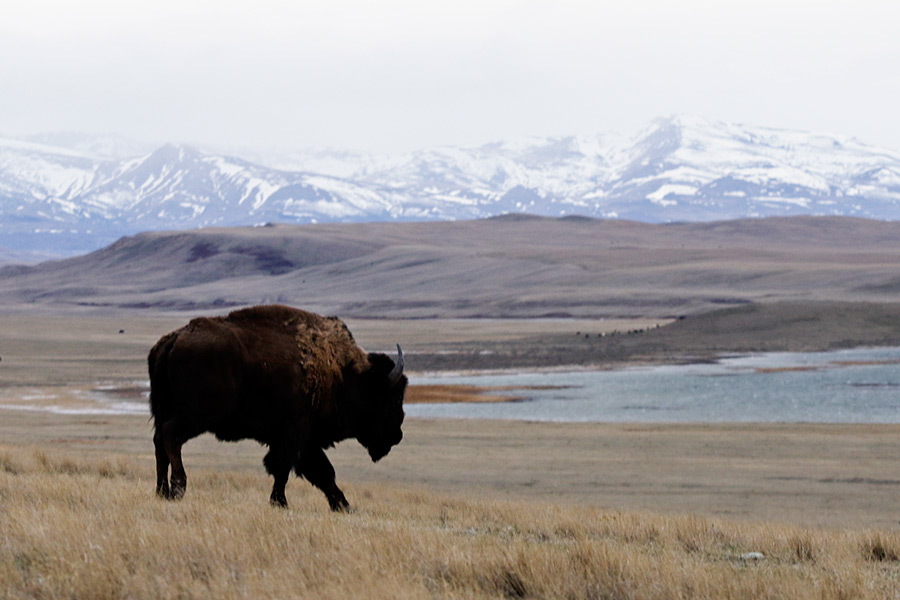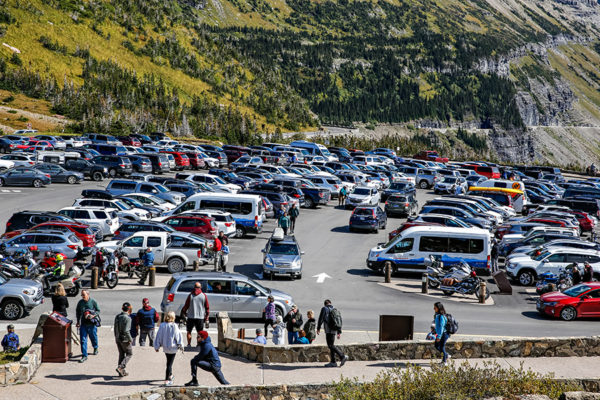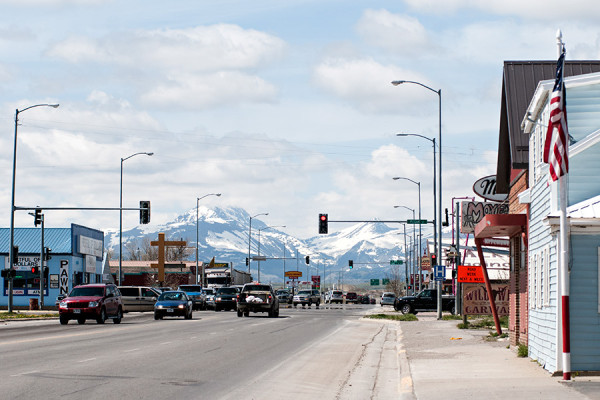A Culture at Stake
On the Blackfeet Indian Reservation, girding against a pandemic is key to preserving the health of tribal members as well as a vulnerable yet enduring culture
By Tristan Scott
A dramatic expanse of snow-marbled mountains runs like a borderline along the Blackfeet Indian Reservation’s western edge, where a sea of rolling foothills intersects the rugged Rocky Mountain Front.
The wild landscape is striking for its beauty, but it is also symbolic. It marks a political boundary between the Blackfeet Nation and Glacier National Park, which shares its eastern border with the tribal reservation as well as a rare ecosystem rich in wildlife and natural resources. Grizzly bear recovery areas and spring rangeland transect the boundary with tribal lands, as do quaking aspen, ground water, roving elk herds, bighorn sheep, wolves, eagles and bull trout.
It’s a pristine landscape melded inextricably with an enduring culture, both resistant to change. Still, the threat of a pandemic that has gripped the world has betrayed unique vulnerabilities to Blackfeet traditions passed down from generation to generation by tribal elders who are the most at risk of disease.
“It’s a very fragile situation,” John Murray, who has served as the Blackfeet Tribal Historic Preservation Officer for nearly two decades, said. “Our elders are our gatekeepers. They know our language and our songs and they exchange sacred gifts through ceremony. And they are the most vulnerable to COVID-19.”
The vitality of Blackfeet culture has been tested before — by government-imposed assimilation policies, broken treaties, development pressure, military massacres, and diseases like smallpox. As COVID-19 spreads worldwide, and as the consequences of history continue to ripple through Blackfeet culture today, many tribal members fear the virus could once again jeopardize those values by endangering their most vulnerable and cherished community members.
“We have been part of a pandemic before,” Murray said. “We have a very close connection and we know what we stand to lose. We are cognizant of that potential, and we are trying to prevent that from happening again.”

The fears are underscored by the reservation’s proximity to Glacier Park, which draws millions of visitors each year, hundreds of thousands of whom access the park by crossing tribal lands. The potential for tourism to exacerbate the public-health crisis during the pandemic isn’t lost on park administrators or the gateway communities whose economic vitality is linked to seasonal visitation.
“We are 100 percent committed to coordinating with the tribe on how to respond to and manage this situation,” Glacier Park Superintendent Jeff Mow said. “COVID-19 is a serious threat for the Blackfeet as far as having the potential to impact their culture, which places such high value on elders. We recognize the need to be sensitive to that, and so do our partners.”
In late March, the park closed to visitors until further notice as cases of COVID-19 crept steadily upward in Montana, where state, county and tribal governments responded by introducing measures to slow the spread of coronavirus. Just like in most parts of the country, organizers canceled events, bars and restaurants closed, and people began adjusting to the practice of social distancing and sheltering in place.
As the rate of disease slows in Montana, Glacier Park will consider a phased reopening this summer, though Mow anticipates a season that is dramatically different than in years past. Not only has the park made steep cuts to its normal inventory of seasonal employees, but the concessionaires and private entities that operate restaurants, gift shops, lodges and other visitor services have delayed opening.
Xanterra Parks & Resorts, operator of lodges inside the park as well as the popular Red Bus tours, is trying to determine how the 2020 season will unfold, but it has pledged to consider the tribe’s interests as it adjusts staffing needs and shifts opening dates. Marc Ducharme, general manager for Glacier National Parks Lodges, said if Xanterra does open, it would be a delayed start. The earliest any of its services would begin in the park is June 15. The company previously planned to have the lodges open in May and early June.

Similarly, Glacier Park Collection, the company that operates Glacier Park Lodge and other services on tribal lands, says it won’t open until federal, tribal and state officials deem it safe to do so.
The cooperation is a relief to Blackfeet leaders now entering their third month of pandemic-response measures, and who earlier this month reported the first death of a tribal member as a result of COVID-19. As of May 11, Glacier County, where the reservation is located, had confirmed only six cases of the disease, which tribal leaders attribute to a proactive and cooperative response.
Even before COVID-19 was reported on the Blackfeet Indian Reservation, the tribe acted aggressively, closing schools, restricting businesses and canceling ceremonial events like powwows.
James McNeely, the tribe’s public information officer, said additional precautions included implementing a 10 p.m. curfew, as well as community outreach through a Facebook page, which features tribal health experts, incident command updates and tips on how to access other resources, such as mental health support.
The tribe also passed an ordinance authorizing coronavirus-related expenses through the tribal government and ensuring the council had the means to coordinate with federal and state entities.
“The safety of the Blackfeet Nation is our foremost priority,” McNeely said. “When we first learned of coronavirus, our response was immediate. We treated it like a disaster.”

The safeguards will remain in place at least through the end of the month, and perhaps longer, even as Montana begins easing restrictions and reopening certain aspects of its economy, according to Robert DesRosier, head of the Blackfeet COVID-19 Incident Command Team.
“The safety and wellbeing of our elders, children, families, and communities is paramount,” DesRosier said. “Relaxing stay-in-place restrictions or resuming large public gatherings runs the risk of undoing the work we have all done together over the last two months. The Blackfeet community should be proud of our collective work as we see that physical-distancing efforts and stay-at-home orders have slowed the rate of COVID-19 infections.”
A resurgence of the virus, either through out-of-state travel or the relaxation of other restrictions on and around the reservation, could have a disproportionate impact on members of the Blackfeet, as evidenced on reservations in other parts of the country.
According to Indian Health Services, there are more than 3,600 confirmed cases of the coronavirus among Native American tribes, with more than 2,000 of them on the Navajo reservation, which stretches across parts of Arizona, New Mexico, and Utah and is home to 250,000 people. As of May 1, the Navajo nation had the third-highest per capita rate of COVID-19 in the country, after New Jersey and New York. Worsening the situation, Native Americans appear to have a higher risk of serious complications because they are likelier to suffer from diabetes, heart disease, and other conditions.
Blackfeet leaders say they are fortunate to have avoided that degree of devastation so far, but emphasized the need to remain vigilant.
The rate at which the virus spreads is compounded on the reservation, where poverty and unemployment remain disproportionately high and low-income housing often accommodates multiple generations of families, with elders sharing quarters with grandchildren.
Darrell Norman, owner of the Lodge Pole Gallery in Browning, said he wishes life could return to normal because his business depends on tourism, but he’s sensitive to the health and safety needs of his community, as well as his own family.
“I’m one of those elders who’s at risk. I’m 78 years old, and I’ve lost mentors who pass on the cultural knowledge that keeps us going,” he said. “This pandemic has sunk my business, but you can’t have our people getting sick and dying without incurring greater cultural costs. Most families live in crowded spaces shared by multiple generations. It’s the kind of situation where, if the virus takes root, we could become an epicenter.”
According to Murray, Blackfeet culture has been enjoying a renaissance in recent years as younger generations shed the stigmas attached to Native Americans by centuries of oppression, and he’s optimistic that momentum will continue to build.
“Our Blackfeet culture is still intact, but it is in a fragile and delicate state. The knowledge is held and passed on by certain elders,” Murray said. “As Tribal Historic Preservation Officer, I have traveled to many different tribal nations during the last 18 years. Often, I am saddened by their loss of culture. Some tribes only have a sweet grass braid and a cigarette lighter. We are lucky to be Blackfeet.”
“The unusual time of COVID-19 has caused me to think of how we have survived and kept our ancient teachings intact through starvation, biological warfare, massacre, and policy,” Murray continued. “It was because we have had great leaders.”

Earl Old Person, 91, served as an elected leader of the Blackfeet for 56 years, longer than any other elected official in Montana history. During that time, he was named president of the National Congress of American Indians, earned an honorary doctorate from the University of Montana and was awarded the Jeanette Rankin Civil Liberties Award.
As Blackfeet Chief, Old Person met the British royal family, the Shah of Iran, and every U.S. president from Harry Truman to Barack Obama, with whom he corresponded in an effort to protect the nearby Badger-Two Medicine area in perpetuity. The sacred landscape is named for the two rivers that spill from its mountain heights, is home not only to a suite of rich natural resources but also to the Blackfeet creation story, and the linkage between the tribe’s cultural heritage and the land is as inextricably forged as the prairie’s connection to the alpine peaks.
“These ancient lands are among the most revered landscapes in North America and should not be sacrificed, for any price,” Old Person wrote in a 2015 letter to President Obama, urging him to “permanently protect the integrity of our cultural and natural heritage.”
For years, the Badger-Two Medicine has been threatened by energy development, and the efforts by tribal leaders, conservation groups and stakeholders to retire the last remaining oil and gas leases have spurred elaborate partnerships and built powerful alliances in recent years.

To highlight those efforts, stakeholder groups like the Pikuni Traditionalist Association, Blackfeet Headwaters Alliance, Glacier-Two Medicine Alliance, Montana Wilderness Association, National Parks Conservation Association, and The Wilderness Society planned to hold a celebration this summer, but canceled it due to the onset of coronavirus.
With a small budget, the group pooled its resources to purchase personal protective equipment for the tribe instead, donating thousands of masks, gloves, and gowns.
“What’s at stake is different in Blackfeet Country because of its cultural resources, and the Badger-Two Medicine since time immemorial has been a place of solace, a place of refuge and a place of healing,” Michael Jamison, of the National Parks Conservation Association, who helped purchase and deliver the aid, said. “So it makes sense that maybe we were able to offer a little bit of healing to a culture that has given us so much and fought to protect a place that is so sacred. There are very few places like it on the planet.”